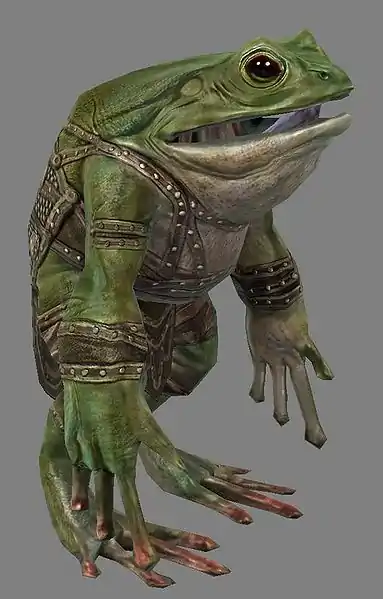Hylek (5e Race)
Hylek
A hylek warrior has already survived the greatest battle he will ever face; he has seen death a hundred times over. What does he have to fear after surviving such odds?
Physical Description
 |
|---|
 |
The hylek are wide-mouthed frogmen with lashing tongues. Hylek thrive in all types of water, but prefer to live in swampy areas. Despite this preference they can be found far away from their spawning grounds. All hylek have a set of poison glands filled with deadly toxins, each being immune to their own toxins and a variety of other poisons. Hylek are renowned alchemists for their mastery of poisons and antidotes.
Hylek come in wide variety of colors with each tribe having a unique color. The color hints at their aggressiveness which correlates to the deadliness of the toxin they produce. Blue hylek are always friendly, green are mostly friendly, orange/yellow are mostly hostile, and red are almost always hostile.
Hylek are capable of multiplying extremely rapidly. Hylek are born in broods as helpless tadpoles in schools of hundreds or even thousands. The early life of a hylek is a battle for survival allowing only the strongest and most aggressive hylek to survive. The average life span of a hylek is relatively short, a hylek dying of old age might die in their forties, but few make it to that age as hylek life often ends prematurely through violence or starvation.
Most hylek's preferred diet are various kinds of insects, usually types of flies, though they will also eat truffles and fish as well. Bored Hylek will often use their elastic, whip-like tongues to idly catch insects. Tribes in dryer climates have been known to herd giant beetles.
The Hylek tribes within isolated rainforests vary largely from the common hylek of coastal marsh areas. The Nuhoch Hylek are far larger and physically resemble cane toads, while the Itzel Hylek resemble tree frogs.
Society
The hylek divide themselves into different tribes which can be differentiated by their color. Each tribe has a different toxin strength, those with the strongest toxins are the most aggressive. Tribe size can vary from dozens of members to hundreds. Due to their territorial nature, it is nearly impossible to get two tribes to cooperate. When two tribes claim the same land they often wage war until one or both tribes are destroyed. "Hylek" was once the name of a single tribe among the race, but in the past few centuries, it has expanded to refer to the race as a whole.
The tribe oversees care of a new brood of youngsters with minimal effort, leaving individuals to fend for themselves. When a brood of young hylek matures, a coming-of-age festival is held where they have competitions to show off the young hylek's strength and value to the whole tribe. How the hylek perform during the festival determines their role in the tribe for life, such as whether they become warriors or merchants.
Due to their high resistance to toxins, hylek often experiment with poisons, their antidotes, and other compounds, which in turn makes them highly valued alchemists. This has allowed hylek to form an economy with other races and groups. Other races sometimes accept hylek as apprentice alchemists, allowing both races to gain new knowledge. Even the asura value the hylek for their alchemy. In most other areas, however, they fall short when compared to other races in terms of advancement, but they have made, and are still making, significant progress in social development over the last few centuries.
Hylek society is divided into individual tribes. Each tribe is led by a single chieftain who has absolute rule, however the chieftains often consult the priests and elders for advice in order to keep favor among the tribe. When dealing with those outside their tribe, hylek send speakers, or Tlatotetl in their language, to perform the negotiations and trade.
Hylek who make it through their harsh lives into old age are deeply respected by the tribe and are often asked for counsel on difficult issues or for judgment during disputes among the tribe.
Some of the common names for different types of hylek warriors have translations into Common. "Amini" means "hunter", "Cuicani" means "singer", "Nahualli" means "sorcerer", and "Tlamatini" means "wise".
Religion
The hylek do not have a faith in gods but rather revere the sun as a nameless divine entity, believing it to represent both good and evil. To hylek, the sun is the bringer of life-sustaining heat and bounty, as well as the harbinger of drought and famine. They often hold festivals on the solstices to celebrate the waning and waxing of the days' lengths.
Hylek priests and shamans are masters of reading the sun and the sky and each tribe has at least one priest, if not more. These priests interpret the sun and the sky for weather patterns that could tell when it will rain and how long dry seasons would last. Among the hylek, it is often considered that an accurate priest is one of the most important factors for the prosperity of the tribe.
Hylek tribes in the rainforests worship an animistic nature goddess named Ameyalli. To the Itzel and Nuhoch tribes, Ameyalli is both the spirit and substance of the jungle itself, and as such any challenge, prey, and predator that enters the jungle is a blessing (or blessing in disguise) sent by Ameyalli.
Hylek Names
Hylek personal names and toponymy are Nahuatl (Aztec, Mexica) -based.
Names: Tizlak, Ibli, Copuul, Ecolotl, Huayapl, Ubek, Acopa, Mayatl
Hylek Traits
The Hylek are a species of alchemically-inclined tribal frog-men.
Ability Score Increase. Your Constitution score increases by 1.
Age. Hylek are born as tadpoles and fight amongst each other for the right to reach maturity over the span of about 4 years. Their lifespan is relatively short and fraught with danger- Hylek that live to see 40 are considered wizened elders.
Alignment. Most Hylek tend to have a great respect for their elders, environment, and tribe. As such, they tend towards Lawful alignments.
Size. Your size is determined by your subrace.
Speed. Your speed is determined by your subrace.
Natural Alchemy. Your body naturally produces toxins that your kind use to create various alchemical compounds. You have advantage on saving throws against poison, resistance against poison damage, and proficiency with alchemist's supplies.
Standing Leap. With or without a running start, when you long jump you cover a distance of up to 25 feet, and when you high jump you clear a height of up to 15 feet.
Languages. You can speak, read, and write Common and Hylek. Hylek is a rhythmic, guttural language, spoken with deep croaks and twanging chirps that can be difficult for non-Hylek to emulate.
Subrace. The three main species of Hylek are Sun Hylek, Itzel, and Nuhoc.
Sun Hylek
The Sun Hylek are the most common species of Hylek, making their homes in coastal marshes and their surrounding areas. They worship the sun as an entity of both good and evil, bounty and drought, and often host tournaments to celebrate the solstice. The winners of these tournaments are declared the champions of the sun, and hold great influence within the tribe.
Ability Score Increase. Your Strength score increases by 1.
Size. Sun Hylek are rather stout, and stand between 4 and 6 feet tall. Your size is Medium.
Speed. You have a base walking speed of 30 feet and a swim speed of 30 feet.
Amphibious. You can breathe both air and water.
Hylek Potions. Sun Hylek are renowned for their skill with healing potions, ointments, and antidotes. You have proficiency with the herbalism kit.
Savage Attacks. When you score a critical hit with a melee weapon attack, you can roll one of the weapon's damage dice one additional time and add it to the extra damage of the critical hit.
Itzel
The nimble Itzel tribe live in treetop canopies deep in the jungle. Among their network of treehouses and bridges, they continually develop ways to traverse and survive in their home environment. The Itzel have been known to augment their speed and agility using strange magical fungi, pass through deadly poisonous hazes unharmed, and have even crafted gliding mechanisms that allow them to soar through the trees. The most powerful of the Itzel's adaptations, though, must be their symbiotic relationship with the giant, ground-dwelling Nuhoch.
Ability Score Increase. Your Dexterity score increases by 1.
Size. Itzel are very slender and can stand anywhere between 4 and 7 feet tall. Your size is Medium.
Speed. You have a base walking speed of 30 feet and a climbing speed of 30 feet.
Hold Breath. You've learned how to avoid the lethal clouds of poison used by both dangerous jungle flora and enemy hylek tribes. You can hold your breath for up to 15 minutes.
Itzel Hunting Techniques. You have proficiency with blowguns, darts, nets, shortbows, and the poisoner's kit.
Mask of the Wild. You can attempt to hide even when you are only lightly obscured by foliage, heavy rain, falling snow, mist, and other natural phenomena.
Nuhoc
The Nuhoch are giant, toad-like hylek that live in burrows beneath the tangled roots and stumps of titanic jungle trees. Like their friends and allies the Itzel, the Nuhoch have spent centuries developing ways to survive in dense rainforests. Though the Nuhoch themselves tend to move at a very deliberate pace, their elaborate tunnel network of Nuhoc wallows allows them to quickly and safely navigate the dangerous, labyrinthine jungle.
Size. Nuhoc tower above their Sun Hylek cousins and Itzel allies, standing between 10 and 15 feet tall. Your size is Large.
Speed. You have a base walking speed of 20 feet and a burrowing speed of 5 feet.
Back to Main Page → 5e Homebrew → Races


